�Performance
A friend saw me using the Pixel and asked if he could give it a try. After admiring the design and hardware he opened it up and said, “But this is basically just an iPad with a keyboard, right?” I didn’t know how to answer the question. I’d never considered the comparison, indeed I didn’t even think to include the iPad 4 as a point of reference in this review. How is the Pixel like an iPad? It took me a while to process, but I think what my friend was getting at is that the Pixel is primarily for consumption, in the same way as the iPad. Different approaches to the future of computing, with the same pitfalls. I got the same feeling from reading Anand’s Surface Pro review. Microsoft is so convinced that this hybrid strategy is the way to go, but in their case the hardware falls short, providing an imperfect tablet and notebook experience. Meanwhile, the aforementioned iPad has excellent tablet hardware and software, but trying to get work done on one is mostly folly; chock it up to a form factor that doesn’t hold up for lots of typing and a UI that’s better suited to the unitasking of media consumption than the multitasking of even the full GMail/GTalk website.

Chrome OS, as Google’s foray into the future of computing, suffered from some pretty modest hardware. Yet in real terms, even the lowly Atom Chromebooks outpaced the silicon found in even the iPad 4. But faster silicon and a speedy browser never seemed quite good enough. And that’s where the Pixel comes in. With the Pixel we’re looking at what is honestly pretty humble silicon, nearly identical to the processor in the 13” MacBook Air. What you get, though, is performance that rivals the better endowed 13” Retina MacBook Pro.
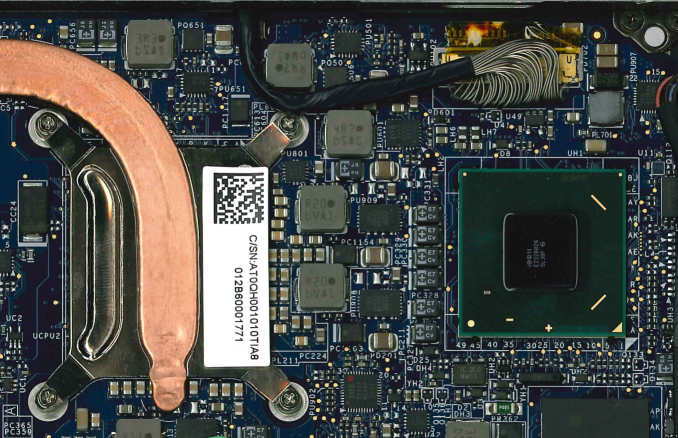
Pixel's Intel Core i5-3337U SoC (under cover)and HM75 Chipset
As always, the Chromebook test suite is something of a grab bag from several categories. Our tablet tests get good representation here, alongside some tests we’ve been incorporating for Surface reviews. As hard as it is to benchmark on Android, it’s much worse on Chrome OS.
We start with our Javascript tests, including our age old friend, Sunspider. This test is so long in the tooth that we’re on the verge of seeing two digit test times. The test gives us a good idea of how far apart the lowest players in compute are versus the highest, and that’s without including any top of the line devices. Within a given performance category, though, the differences become small.
If you just wanted to establish that the Pixel belonged in a class apart from the history of Chromebooks, and tablets for that matter, this is it. The Pixel’s performance here is close enough to the the rMBP as to consider it a draw, though the Surface Pro in IE seems to beat both soundly. This is something of a cake walk for this caliber of hardware, so let’s look at something a bit more demanding.
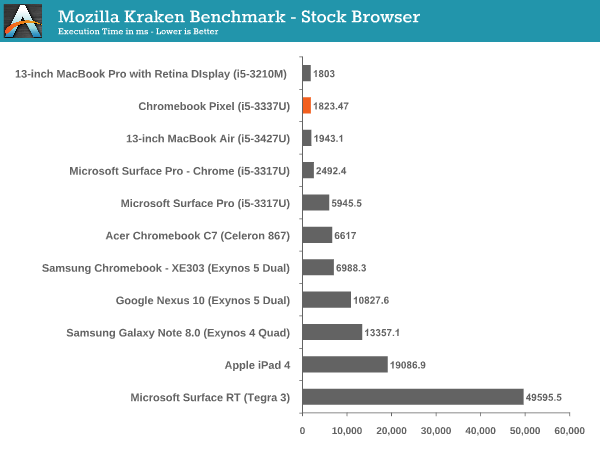
Mozilla Kraken is the next iteration in Javascript tests, with a much more strenuous workload, though it is already rapidly approaching sub-1,000 ms scores. Against the Surface Pro, the Pixel comes out way ahead here, even with the field leveled by running Chrome as the browser. There’s a clock difference of just 100 MHz between the Pro and the Pixel, not nearly enough to account for the difference in performance. This may be a situation where the Chrome OS conceit bears fruit; by eliminating the cruft of other operating systems, more resources can be devoted to the task at hand. Once again, the Pixel and the rMBP sit neck and neck with each other, despite a 15% maximum clock advantage in the rMBP’s favor. The rest of the pack? An order of magnitude behind.
Kraken and Sunspider don’t make for terribly well-rounded tests; what we want is something that can tax CPU, memory, and even GPU and local storage. For something approaching that we’ve added WebXPRT from Principled Technologies. The test actually simulates real world web applications and should give us a better idea of how the different platforms stack up when viewed from a wide angle lens.
The rMBP has a definite edge over the Pixel here, showing a chink in the armor. We haven’t explored WebXPRT enough to say for certain what components are being exposed in each subtest. It’s possible that memory limitations played a role, or the clock advantage in the rMBP just needs a longer test to have its value exposed. Regardless, the test does still make clear that in this group, the Surface Pro, Pixel and rMBP are alone at the top, and the Surface Pro is just barely hanging on.
WebGL is a developer tool that’s quickly gaining popularity, though it remains mainly the stuff of tech demos. If gaming is to be a serious component of the web as a platform, then a robust API must exist and supported hardware must perform adequately. When the Acer C7 Chromebook crossed our path we were impressed with Intel’s HD 2000 graphic’s ability to outperform the Atom offerings and even Samsung’s Mali GPU. Now we have HD 4000, in a few iterations. Testing WebGL capabilities is not the easiest affair, despite the number of tech demos, but we chose a few and measured up our players.
These results go a long way to demonstrating how challenging it is to compare such disparate platforms. Though the rMBP and Pixel both use Intel’s HD 4000 graphics, they’re each configured slightly different. The rMBP has the base clock advantage (650Mhz to the Pixel’s 350MHz), but each has the same maximum frequency (1.1GHz). That max is theoretical, tough and the reality of notebook design is that device thermal characteristics will weigh heavily on whether that maximum is achieved, and for how long it might be sustained. There’s also the fact that these devices run drastically different operating systems, and so these tests become more about how their respective platforms handle WebGL given roughly similar hardware. The loose results shine very positively on Chrome OS, less so on Chrome on OS X.
The WebGL aquarium test was particularly anomalous, with the Pixel hitting v-sync even after raising the number of visible fish to 1,000. Again, these tests don’t establish a firm graphics performance advantage for the Pixel, but simply look at the ability to render WebGL graphics. There is a direct relationship with the Pixel and the Chromebooks that preceded it and here we can say with certainty that the advantage goes to the newcomer. Anand described in his review of the Samsung Chromebook (XE303) having to watch even simple games stutter and drop frames. The same remained true in the Acer C7. The Pixel removes that concern, and establishes a performance watershed for WebGL; WebGL developers that want to what platform puts their best foot forward need look no further.
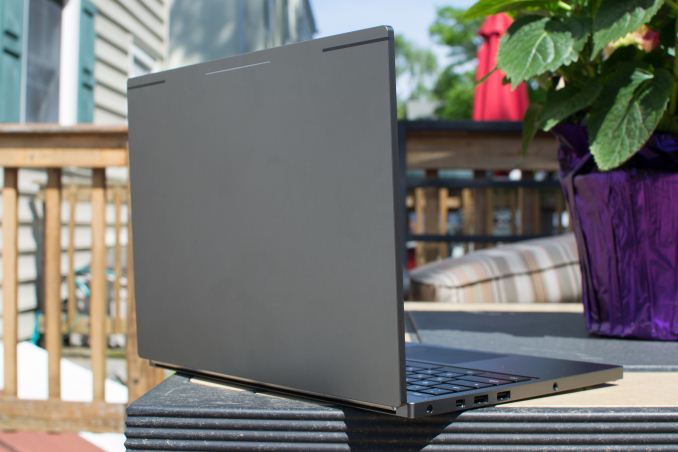
After all that, though, there’s a certain subjective reality that we must discuss. Even owners of workstation class PC’s have experienced poor performance in their browser. Web sites are increasingly complex, able to generate multiple threads within themselves and consuming impressive amounts of resources. And even when there’s not much going, perhaps a few display ads on a long column of text with images interspersed, you can still encounter stutter and hesitation as you scroll through the page. Or there’s a long delay after triggering an action in a web app, before seeing the appropriate reaction. The culprit could be network in nature. It could be related to the app itself. Or it could be, that a background process needed those compute cycles for a bit, before relinquishing them to complete your task. Chrome OS removes that confound, while also working to mitigate network delays. And the result is palpable. Even in Gmail, derided for some time now for its laggy performance, feels fluid and responsive. Playing a simple 2D canvas game could be an exercise in frustration in the C7 or even my MBP, but in the Pixel you never perceive anything but v-sync. There’s something to this experience that can’t quite be measured with the tools we have, but it’s there, and it’s really nice.
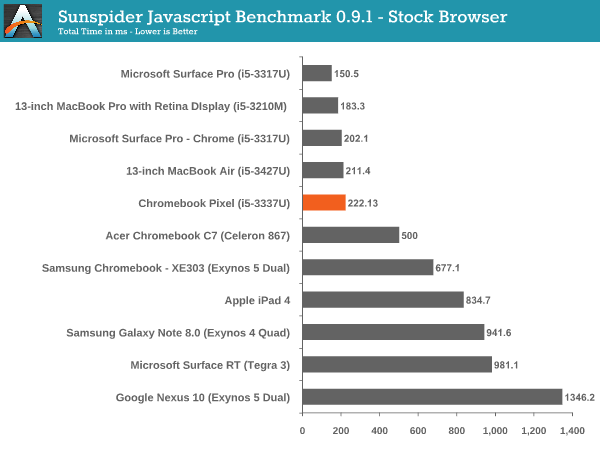

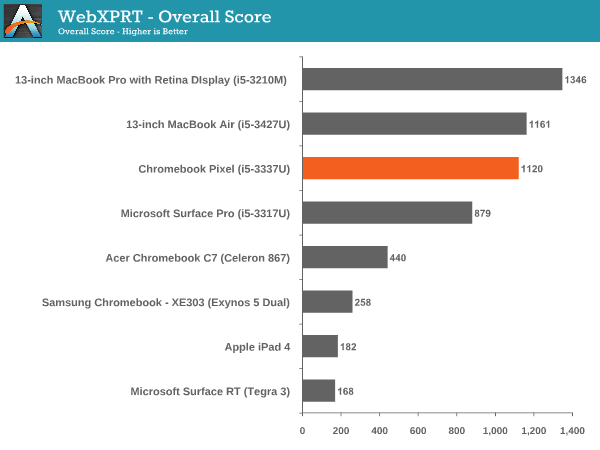


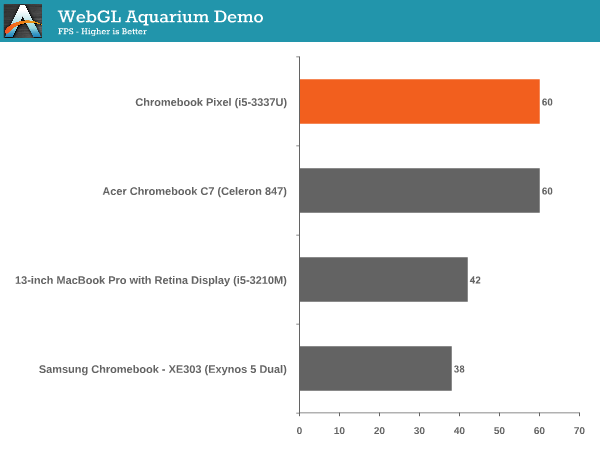












74 Comments
View All Comments
cjb110 - Friday, May 31, 2013 - link
Excellent review, would be perfect for my intend usage...just need to be able to afford one:)Adhib - Friday, May 31, 2013 - link
Why don't you just get one of the Samsung Chromebooks?jeffkro - Monday, June 3, 2013 - link
They're ok, but the screen resolution kind of stinks.xyzzy1 - Friday, June 14, 2013 - link
I'd rather buy the mackbook and run windows on it. Overall better specs and better overall build quality.Belard - Friday, May 31, 2013 - link
Wow... I know I read it before... but still... the thing has far higher resolution than my 24" display.Even thou its a desktop and twice the distance away from my eyes... I can see the jaggy pixels on my 24" monitor that I cannot see with my Android phone or a modern tablet.
Its good to see something going against the dead-end Windows platform.
Interesting thou... and funny in a way, Dailytech is a malware site?
damianrobertjones - Friday, May 31, 2013 - link
What? 'Dead-end windows platform'? Yeah ok.This might have a higher resolution than your 24" screen but which has more 'working' space...
Alexvrb - Saturday, June 1, 2013 - link
This might compete with expensive Apple hardware, but it's not a direct competitor to Windows-based Ultrabooks/Ultrathins. Maybe if it was $500 cheaper. The display is awesome, the chassis is pretty, but that's it. The memory is on the low side, and is not upgradeable. The internal storage (fairly fast) is very limited and also not replaceable. The CPU is inferior even to the one in the Air. Etc.There's little chance anyone who has the word "affordable" in their vernacular would buy this over an Ultrabook. I don't personally think browserOS is all that great anyway, but if you're going to buy a Chromebook the cheap ones are the way to go. If Google was really out to help the open source community (like they pretend to be, meanwhile using them like any other tool), they would have built their own flavor of Linux with Google Happyware integrated and would use that instead.
Selden - Saturday, June 1, 2013 - link
Alexrvb: The CPU spec is identical to that in the 13" Macbook Air: 1.8 i5 @ 1.7gHz, with Intel® HD Graphics 4000.jeffkro - Monday, June 3, 2013 - link
Have you used chrome OS? Its extremely lightweight and doesn't need much in the way of cpu and memory. Its even blazing fast on a celeron 847.JDG1980 - Friday, May 31, 2013 - link
"So, how do you cope 4 million pixels and just 4GB RAM? In this case, the first step is to render all pages at 1280 x 800, unless HiDPI assets are available. The final product is upscaled to the full 2560 x 1600, but the memory doesn’t take nearly the punishing you might expect; unless, of course, every site you visit has HiDPI assets."So you're not even getting sharper text, just blurry low-res text upscaled? That sucks. What's the point of having a HiDPI display at all?
I'm not at all impressed with the notion of a browser-only OS. It is not and never will be enough for serious users. And I don't want Google to be monitoring every single thing I do on my local PC. "The cloud" can go take a flying leap.